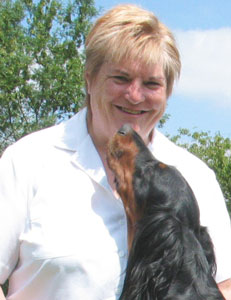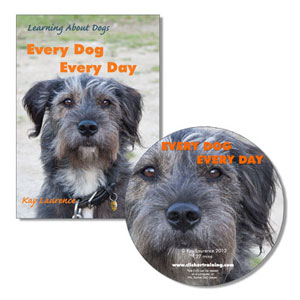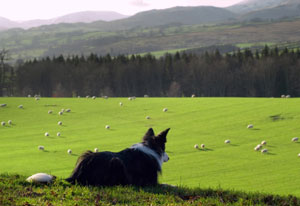Editor's note:
On a working farm in the English countryside, nearly a mile from the nearest road, people and dogs come together from all over the world to learn from one of the world's top trainers, Kay Laurence. Kay has been teaching, writing, and training dogs from her UK-based home and farm for more than 35 years. What she teaches is far more than just training skills. Her philosophy, developed from her years of living with and observing dogs, is that that we should give dogs equal consideration and try view the world from the dog's perspective. Only then can we achieve a relationship with dogs based on connection and pleasure.
This philosophy is the premise of Kay's new book and DVD set, Every Dog Every Day. Chock-full of the thought-provoking, out-of-the-box insight that Kay is known for, and heavily sprinkled with her celebrated wit and candor, Every Dog Every Day is a culmination of Kay's 35 years of teaching and training people and dogs.
Grab a cup of tea and read on as Kay shares some tasty tidbits from her tried-and-true recipe for creating greater connection with your dog.

You are well-known for your unique approach to puppy rearing and dog training. How would you explain your training philosophy?
I would like the world to give the same consideration to dogs as to their owners. Many training protocols profess to fix a problem, but often at a cost to the dog. Discomfort, loss of freedoms, and loss of the right to say "no" are all examples of costs to the dog. My voice is the counter-balance to give consideration to both parties in any training, management, or interaction.
How easy is it for your clients to implement this philosophy?
My clients welcome a range of techniques for achieving a balanced relationship without compromising their dogs' well-being. My statement that their dogs are not the enemy, and should not be judged as less than perfect, in behaviour or looks, is very welcome. We invite dogs into our lives because we love dogs and want to share a long-term friendship and connection. The judgement of passing strangers, friends, or relatives should not intrude into that relationship.
There are emergency situations that disrupt our lives, and those we cannot plan for. But an overall life that contains little to no consideration for the animal you are responsible for caring for (which means more than just putting a bowl of food on the floor) should be questioned.
What was the inspiration for writing your latest book, Every Dog Every Day, and why did you choose that title?

I have a background in dog sports, working, and pet-dog training. While working dogs carry their own respect since they have a "proper job," pet-dog trainers are often referred to as "just" pet-dog trainers. I consider pet-dog training the foundation and the most important dog training, because it affects every dog, every day.
In Every Dog Every Day and in your ClickerExpo presentations, you talk about seeing things from your dog's perspective, particularly when walking out and about together. What's the most important thing that people don't notice about their dogs when out walking?
What does the word "walk" really mean? We go for a walk; dogs go for the sniffing, scenting, marking, cruising, and hunting. If you were window shopping, browsing those speciality shops, you would not call it "going for a walk." What we call something influences how we view it. Go shopping with your dog—in their mall, not yours.
You discuss learning to walk together and being connected. What is the key to achieving that connection?
Consideration and respect for your companion. Many dogs arrive at our facility and look at me as if to ask, "Can you stop this person from pulling me around?" If you were walking with a small child, you would adjust your speed and length of stride, and make allowances for the child's desire to interact with the environment. Once we can identify a mutually comfortable speed when out and about with our dog, many issues simply dissolve. Think of walking with a friend while having conversation.
What do you mean by the twenty-first century dog?
The world in which today's dogs try to live is vastly different. We have selected different breeds and characteristics to share our lives, and breeders have modified their selection process, to some degree altering the types of dogs we have. We have changed dogs' diets to the point that a teeth cleaning is now an essential part of caring for dogs. Inadvertently, we may also have selected dogs with more juvenile characteristics, in looks and behaviour. Those characteristics can prove to be challenging in achieving a balanced adult.
Your book explains that we should not be trying to change dogs, but instead we should change the world in which they live. What do you mean by that?
Change the attitude of people toward dogs—the attitudes of those from the outer world who do not love dogs, and the attitudes of those from the inner world who live with dogs. The expectations are often a continent away from reality.
It is human nature to want to touch and interact with a dog. However, I do not think that it is appropriate for any stranger, or even friend or acquaintance, to touch or pet your dog without asking first. A person should have the grace to step away if the touch is not welcomed. People are trying to live with dogs in more and more inappropriate environments, perhaps without realising the difficulties for the dog.
How do traditional training views create the wrong mindset?
Traditional training often views the process as removing the undesired behaviours. Undesired behaviours—behaviours that people do not like or want, but that may be perfectly normal for a dog. Take, for example, teaching a dog to remain in a stay position. Traditional trainers try to inhibit and suppress movement away from that position through punishment. But when we walk away from a dog, it would be extremely unusual for the dog not to want to step alongside us. That is a normal response.
Modern training may remove the punishment aspect, but still attempts to remove or suppress unwanted behaviours. Even this training often tries to push the dog "against the grain" or against nature. We have to rethink the whole paradigm to see how we can explain clearly to the dog what we want and how to achieve it.
Can you offer some examples of how we can work with the grain instead of against it?

I like to teach the innate predatory stillness inherent in most dogs. You don't get to kill prey if you miss out on the "can watch with stillness" lessons. This inherent behaviour is easy to trigger and, once captured, transfers to many new situations.
Enormous amounts of energy are invested in reinforcing a dog for not jumping up, still with the view of taking away what people do not like or want. Instead, we should look to the reasons that cause this jumping response and provide a solution that gives the dog the connection.
In rearing the modern dog, we can thank Barbara Woodhouse and her friends for designing and manufacturing indoor crates. Crates are now common places for puppy rearing and they also allow the pup to be nearby at night without creating the danger of a free-roaming puppy in the house. As a breeder, I am horrified to hear advice that recommends ignoring a puppy screaming its way through the first few nights. Nature designed this youngster to call for help when abandoned. It is very difficult for an 8-week-old pup to ignore the rules of nature, and it is likewise difficult for your neighbours.
In your book you compare puppy rearing to gardening, with the importance of "developing a good root system." What do you mean by that, and what's the key to developing that optimal foundation for the new puppy?
With all young animals a good upbringing, with a rich, varied and stimulating environment makes for balanced adults. But that environment can also be over-stimulating, often resulting in very tired and fractious youngsters, opening the risk to fearful associations. I recommend a protocol of familiarisation—allowing the individual to choose the degree of interaction and exposure, and where there is common sense above all.
If you could impart just one morsel of advice that would help people and dogs enjoy a relationship of connection and pleasure together, what would that be?
Listen.
Dogs have been trying to communicate with us for generations. It just takes a little time and practice to hear them. Listening seems to be an innate skill we have lost.
Related Products
|
|
|





Post new comment